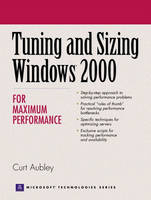
Tuning and Sizing Windows 2000 for Maximum Performance
Prentice Hall (Verlag)
978-0-13-089105-1 (ISBN)
- Titel ist leider vergriffen;
keine Neuauflage - Artikel merken
This is a guide to planning capacity and tuning Windows 2000 systems. This will answer such questions as: How do you size a 2000 server? How do you plan server capacity and make sure that it scales as needed? How can performance be optimized? How do you predict and avoid server bottlenecks? The author is the former chief architect for UNIX-NT integration at NCR and author of Sizing and Tuning NT Server.
CURT AUBLEY is an MCSE and is currently the Chief Technology Officer (CTO) and Chief Information Officer (CIO) for OAO Corporation, a $300 million-a-year company that focuses on IT solutions and enterprise outsourcing. Curt is also the President of the new eCommerce management and security services company MightyView.com. His articles appear in leading trade magazines, including SunWorld and Windows 2000 magazine. Aubley has spent over 14 years working with Windows NT/2000, UNIX, Linux operating systems and networks in e-commerce, performance, and security roles. He has benchmarked, tested, optimized, and sized solutions for organizations such as Raytheon, US Army, AT&T, NCR, and Neal Nelson & Associates, one of the world's leading benchmarking firms.
1. Instant Rules of Thumb for Tuning and Sizing Windows 2000.
Gathering Performance Statistics: Start the Logs. Three Action Items to Complete So That All Relative Performance Counters Can Be Collected. Determining Which Applications (Processes) Are Running under Windows 2000. Windows 2000 Bottleneck Detection Strategy. General Windows 2000 System Observations. Key Performance Metrics to Observe in Detecting System Bottlenecks. Detecting Windows 2000 Bottlenecks. Immediate Tuning Tips to Implement: The Tuning Process. Tuning Windows 2000 Resources. Tuning Windows 2000 System's Network Subsystem. Lower the Overhead Associated with the Network Operations and Improve Efficiency. Windows 2000 Administration-Level Tuning. Network Interface Card (NIC) Tuning. Distributing Windows 2000 Network Load. Tuning CPU Resources. Controlling Windows 2000's CPU Quantum Allotment. Windows 2000 Service Packs. Sizing Rules of Thumb for Windows 2000 Systems. Sizing Disk Subsystems. Disk Subsystem Availability. SCSI Bus Implementation. Determining the Number of Disk Drives per SCSI Bus. Sizing the CPU(s). Sizing Network I/O Subsystems. Network Selection. The Number of Clients per Shared Network Segment. Server Network Interface Card Selections. Sizing Memory Requirements. Implementing Server Memory. Sizing and Tuning Specific Windows 2000-Based Implementations. Summary.
2. Tuning Strategies and Measurement Gathering.
Introduction. Setting Goals for Tuning Windows 2000-Based Systems. The Big Picture: Understanding the Entire Architecture. Tuning Strategy. Practical Guidelines. Tuning Methodology. Achieving a Nirvanic State. Focusing Your Tuning Efforts. The Tuning Process. Performance Baselines. Customizing the CPWMM Scripts. Performance Management. Third-Party Performance Management Tools. Sysmon Operations. Using Auditing to Zero in on Resource Usage. Windows Task Manager. Additional Performance-Related Tools from Windows 2000. Windows 2000 Resource Kit Performance Management Tools. Freeware Performance Management Tools. Windows 2000 System Checkup. Putting It All Together: The Environment. Summary.
3. Capacity Sizing.
Introduction. Goals of Sizing. Reality of Sizing. Sizing Methodology. Exploring the Sizing Methodology in Detail. Benchmarks. Historical Baselines. How Server Architecture Relationships Affect System Configurations. Properly Sizing Memory. Server I/O Relationships. Server CPUs Drive More than Applications Alone. Commercially Available Sizing Tools. Summary.
4. CPU Performance.
Introduction. Central Processing Unit. Pentium III and Pentium III XEON CPUs. Windows 2000 and CPU Resource Usage. Detecting CPU Bottlenecks. Sizing CPU Subsystems. CPU and Memory Sizing Relationships. Tuning Strategies for Removing CPU Bottlenecks. Thinking Outside of the Box. Summary.
5. Windows 2000 and Memory Performance.
Introduction. Memory Hardware Technology Review. How Windows 2000 Uses Memory Resources. Windows 2000 File System Cache. Sizing the Memory Subsystem. Detecting Memory Bottlenecks. Quick Reference: Helpful Tools to Use When Tracking Down Windows 2000 Memory Details. What to Observe in Sysmon When Diagnosing a Memory Bottleneck. Tuning Strategies for Removing Memory Bottlenecks. Hands-on Tactics for Tuning around Memory Bottlenecks. Removal of Potential Memory Road Blocks. Remove Unnecessary Workload from the System. The Last Resort: Purchase More RAM. Summary.
6. Windows 2000 and Disk Subsystem Performance.
Introduction. Disk Subsystem Technology: Following the Data. Disk Drive Technology. Disk Drive Selection. Performance Perspective: Physical Disk View vs Windows 2000 View. Disk Subsystem Performance. SCSI Technology. Fibre Channel Technology. HBAs. I/O Bus Technology and Selection. The System Bus. Redundant Array of Inexpensive Disks (RAID). RAID 1-Disk Mirroring. RAID 5-Disk Striping with Parity. How Windows 2000 Uses the Disk Subsystem. Windows 2000 Device Drivers. Sizing a Windows 2000 Disk I/O Subsystem. Detecting Disk Subsystem Bottlenecks. Tuning Strategies for Removing Disk Subsystem Bottlenecks. File System-Related Tuning. Tuning Disk Subsystem SCSI Channel and HBA. RAID Tuning Considerations. The Most Important Disk Tuning Concept. Disk Storage Capacity Tuning. Additional Disk Subsystem Hardware-The Last Resort. Thinking Outside of the Box: Windows 2000 RAM Disk. Summary.
7. Windows 2000 and Network Performance.
Network Subsystem Technology: Following the Data. Network Interface Card. Relative Throughputs of Different Network Technologies. Realistic Network Throughput under Windows 2000. Windows 2000 and GBE Performance. Applications Can Affect Network Performance. Windows 2000 Ethernet Performance Characteristics. Other Network Technologies. Understanding the Network Architecture in Which Your Windows 2000 System Operates. Windows 2000 Server Placement in the Network. How Windows 2000 Takes Advantage of the Network. Windows 2000 TCP/IP Performance Enhancements. Windows 2000 Network Performance and the CPU. It Takes Two to Tango. Network Subsystem and Intelligent I/O (I2O) Technology. Sizing the Windows 2000 Network Subsystem. Detecting Windows 2000 Network Bottlenecks. Beyond Windows 2000 Systems: Tracking Down Internetwork Device Performance Problems. Tuning Strategies for Removing Network Subsystem Bottlenecks. Summary.
8. Putting Theory into Practice: Sizing and Tuning Back Office Solution Scenarios.
Introduction. Solution Scenario 1: Windows 2000 File Server Consolidation. Scenario 1 Step by Step: Sizing and Tuning a Mid-Range Windows 2000 File Server. Windows 2000 File Server Sizing Configuration Chart Summary. Windows 2000 File Server Tuning Summary. Solution Scenario 2: Windows 2000 Backup Servers. Scenario 2 Step by Step: Mid-Range Windows 2000 Backup Server. Backup Server Sizing Configuration Chart Summary. Windows 2000 Backup Server Tuning Summary. Solution Scenario 3: Windows 2000 Exchange Servers. Scenario 3 Step by Step: Mid-Range (3,000 User) Windows 2000 Exchange Server. Exchange Server Sizing Configuration Chart Summary. Windows 2000 Exchange Server Tuning Summary. Solution Scenario 4: Database Server Implemented with Microsoft SQL 7.0. Scenario 4 Step by Step: Sizing and Tuning Mid-Range Windows 2000 SQL Server. SQL Server Sizing Configuration Chart Summary. Windows 2000 SQL Server Tuning Summary. Solution Scenario 5: World Wide Web Server Implemented with Microsoft IIS 5.0. Scenario 5 Step by Step: Sizing and Tuning a Mid-Range Windows 2000 Web Server. IIS 5.0 Web Server Sizing and Configuration Chart Summary. Windows 2000 IIS 5.0 Web Server Tuning. ASP CPU Optimization. Optimizing IIS for Web Publishing. Thinking Outside of the Box: Xtune. Literally Thinking Outside of the Box: Network Load Balancing. Windows 2000 IIS 5 Web Server Tuning Summary. Web Server Solution Scenario Summary. Summary.
Index.
| Erscheint lt. Verlag | 4.1.2001 |
|---|---|
| Verlagsort | Upper Saddle River |
| Sprache | englisch |
| Maße | 185 x 242 mm |
| Gewicht | 1390 g |
| Themenwelt | Informatik ► Betriebssysteme / Server ► Windows |
| Informatik ► Betriebssysteme / Server ► Windows Server | |
| ISBN-10 | 0-13-089105-3 / 0130891053 |
| ISBN-13 | 978-0-13-089105-1 / 9780130891051 |
| Zustand | Neuware |
| Haben Sie eine Frage zum Produkt? |
aus dem Bereich


